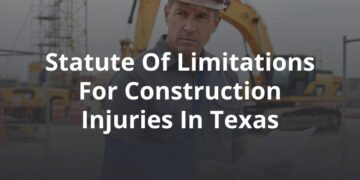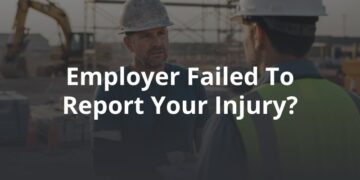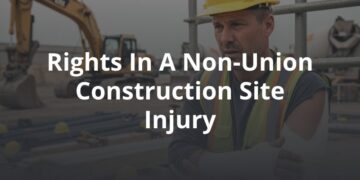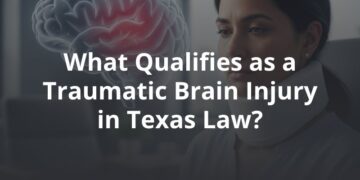Every year, serious injuries and fatalities are caused by falling objects on Texas construction sites. Tools and building materials that are used aloft can fall on unsuspecting workers down below – especially if the proper safety regulations are not followed. Employers and construction site managers are responsible for taking the correct measures to help prevent falling objects and related worker injuries in construction zones.
Struck-By Falling Object Statistics in Construction
Being struck by a falling object is one of the Occupational Safety and Health Administration’s (OSHA’s) “Fatal Four” in construction, meaning the four most common causes of construction worker deaths. The other three are falls, electrocutions, and being caught-in/between objects or equipment.
Statistics show that contact incidents with objects and equipment accounted for 17 percent of worker injuries in the construction industry in the most recent year data is available. “Struck-by falling object” made up more than half of these deaths (10 percent). Every year, hundreds of construction workers suffer serious injuries and die due to dropped objects.
What Are Acceptable Methods for Preventing Dropped Objects at Construction Sites?
Employers in the construction industry have a legal responsibility to protect their workers from foreseeable hazards – including objects that may fall from scaffolds, platforms, roofs, lifts, chutes, buckets, cranes and tool belts. Examples of acceptable methods for employers to use to prevent the risk of dropped or falling objects on a construction site include:
- Tool tethering: securing tools, including ladders and equipment, to a work area through the use of tethers, tool buckets, bins and containers.
- Proper securement of building materials: tethering or strapping all building materials, such as bricks or wood, properly to a scaffold or work area.
- Frequent inspections and revisions: regular inspections of a construction site to check for rule compliance, look for potential risks and clean up debris that may otherwise fall.
- Safety nets: installing nets at various levels to catch falling objects and protect workers and pedestrians below.
- Barricades and warning signs: barriers and barricades can prevent workers from walking into danger zones, while warning signs can notify the public of the risk of falling objects.
- Clear communication: adequate communication among the members of a construction team can help prevent dropped-object incidents at a site.
In addition, all workers at a construction site must be equipped with helmets to prevent head and brain injuries caused by falling objects. 29 Code of Federal Regulations (CFR) 1926.100(a) states that an employee who is working in an area where there is any potential danger of head injury from falling objects, flying objects or impacts must be protected by a helmet.
OSHA Rules and Regulations for the Safe Handling of Objects in Construction
Construction sites must comply with federal regulations and safety standards to help prevent worker injuries and deaths. Several OSHA regulations are in place to prevent dropped objects on construction sites specifically. Employers are responsible for remaining OSHA compliant regarding dropped object risks. Some of the most relevant OSHA regulations are:
- 1910.28: employers are required to provide protection for employees who are exposed to falling object hazards, including head protection, toeboards, screens, guardrails, canopy structures and barricades.
- 1910.29: employers must install falling object protection systems that meet federal requirements, such as using canopies that are strong enough to prevent penetration or collapse by dropped items.
- 1910.176(b): stored materials must be secured properly and limited in height to ensure they are stable and secure against sliding or collapse.
- 1926.250(a)(1): all materials stored in tiers must be stacked, interlocked or otherwise secured to prevent them from sliding or falling.
- 1926.250(b)(5): materials stored on scaffolds cannot be stored in excess of what is needed for immediate operations.
- 1926.250(b)(6): stacks of bricks may not exceed seven feet in height. When a brick stack reaches four feet, it must be tapered back two inches per every foot of height thereafter.
- 1926.759: all materials, equipment and tools that are not in use while working from heights must be secured against accidental displacement.
Construction companies are required to adhere to federal safety standards and Texas-specific regulations for preventing falling objects on construction sites. Violating these codes can result in penalties. Currently, OSHA violations cost around $13,500 per offense. If a construction company is found to be a willful or repeated offender, the cost can increase to nearly $135,000 per violation.
Falling Objects Can Cause Serious Construction Worker Injuries in Texas
Falling objects on a construction site can cause injuries that range from minor to severe. Objects or building materials that fall and strike a worker – or an unprotected pedestrian or bystander –can cause catastrophic injuries, such as traumatic brain injuries and permanent brain damage. Common injuries include:
- Broken bones
- Skull fractures
- Brain injuries
- Concussions
- Eye and facial injuries
- Cuts and lacerations
- Crush injuries
- Spinal injuries
- Soft-tissue damage
- Internal injuries
- Amputations (traumatic or surgical)
- Wrongful deaths
The type and severity of a victim’s injuries will depend on factors such as the weight and size of the object and the height from which it falls. At FVF Law Firm, our Texas work injury attorneys have the experience and resources to help a client who has been diagnosed with any type of injury after being struck by a falling object.
Who Is Responsible for Injuries Caused by Falling Objects on Texas Construction Sites?
Falling objects are a known hazard in the construction industry. Employers and construction companies should be aware of this risk and take actionable steps to prevent these incidents on their construction sites. The careless or intentional failure to fulfill this obligation could lead to a lawsuit against the employer for negligence after a related worker injury.
If a victim was struck by a dropped object due to a product malfunction, such as a faulty scaffold collapsing, the manufacturer of the equipment may be held responsible. The victim may be able to pursue compensation through a product liability claim – a case brought against a manufacturer or distributor for a defective product.
In many cases, workers’ compensation insurance is available to pay injured construction workers without requiring proof of negligence or fault. However, a greater amount may be available through a personal injury lawsuit in some circumstances. This is why it is important to consult with a lawyer before accepting a settlement.
Learn More During a Free Legal Consultation
There are many effective ways to prevent falling objects on a construction site. Careless and reckless behaviors by employers, workers, contractors, manufacturers and other parties involved are often behind a worker being struck and injured by a dropped object.
If you or a loved one was recently injured in this type of accident in Texas, don’t hesitate to contact FVF Law Firm to request a no-obligation and free consultation to learn about your legal rights and recovery options. FVF Law has over 100 years of combined legal experience. Our construction accident lawyers in Austin will listen to your story and guide you through the confusing legal process.






